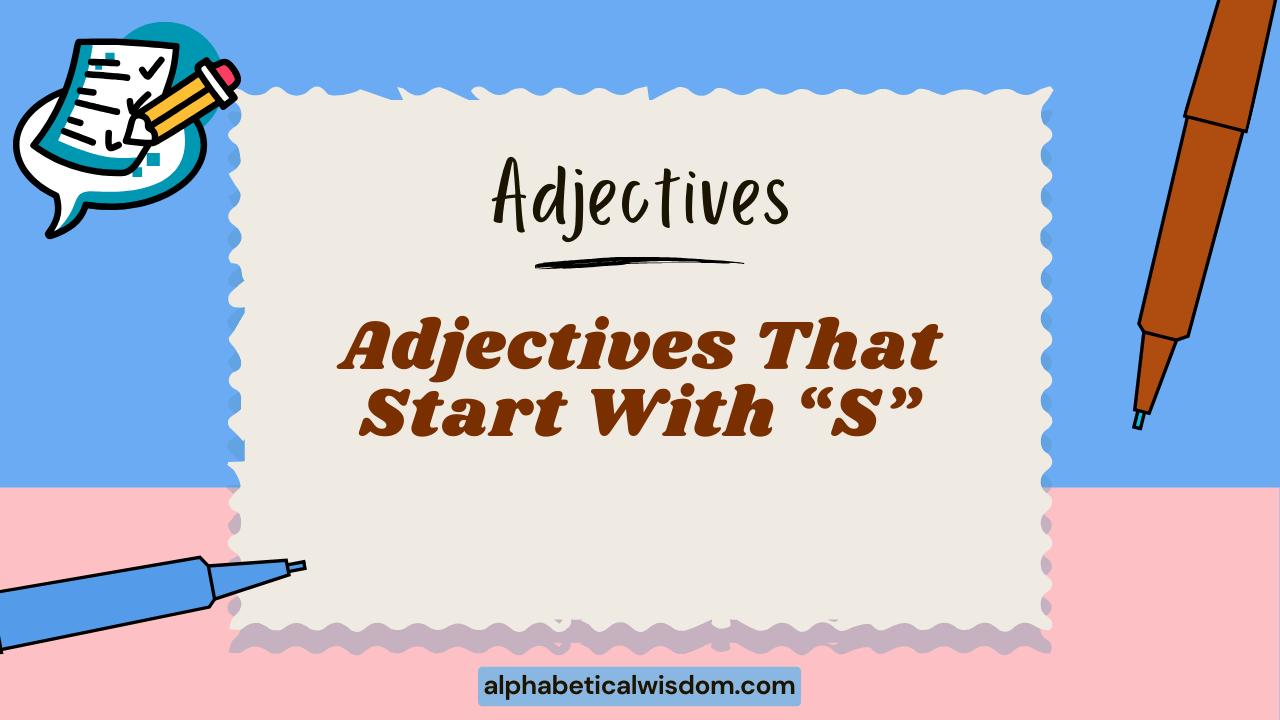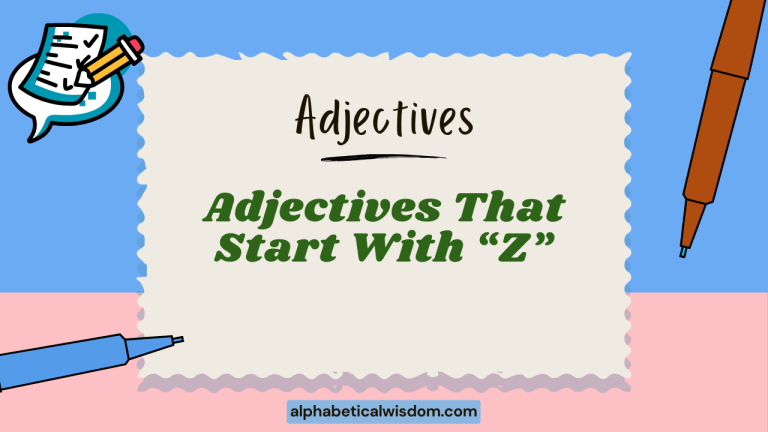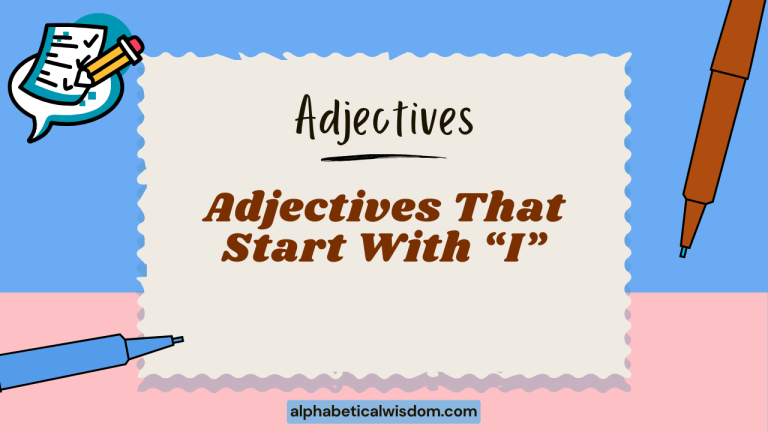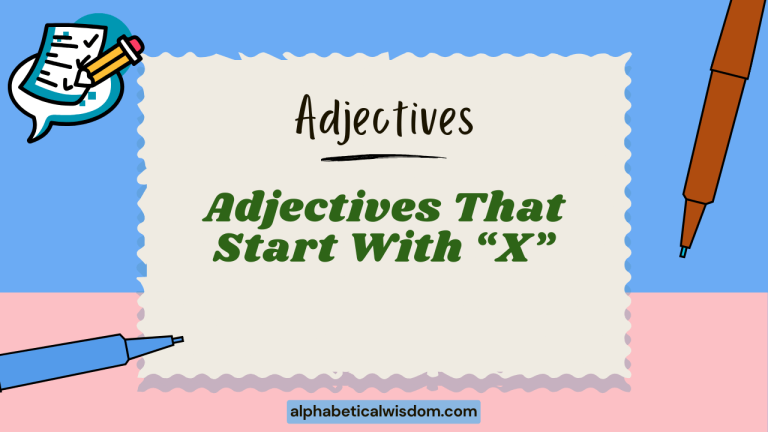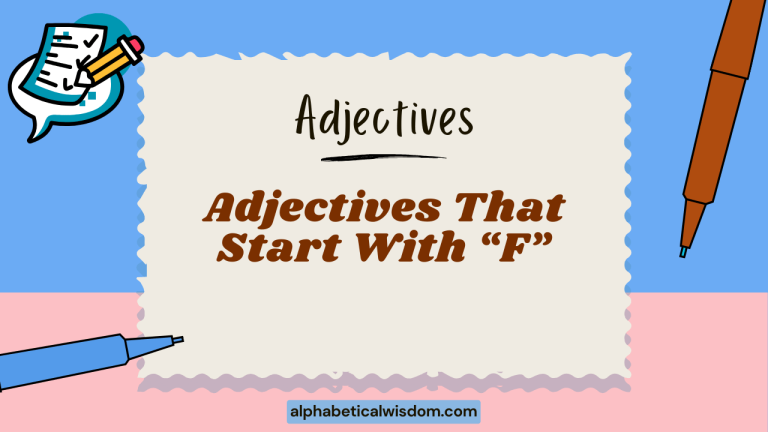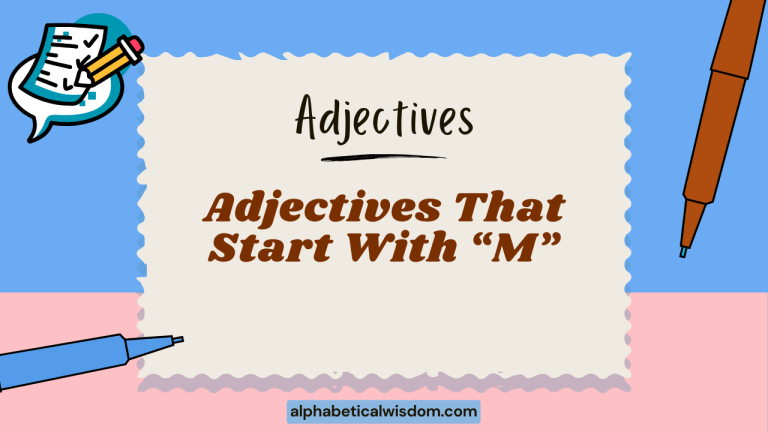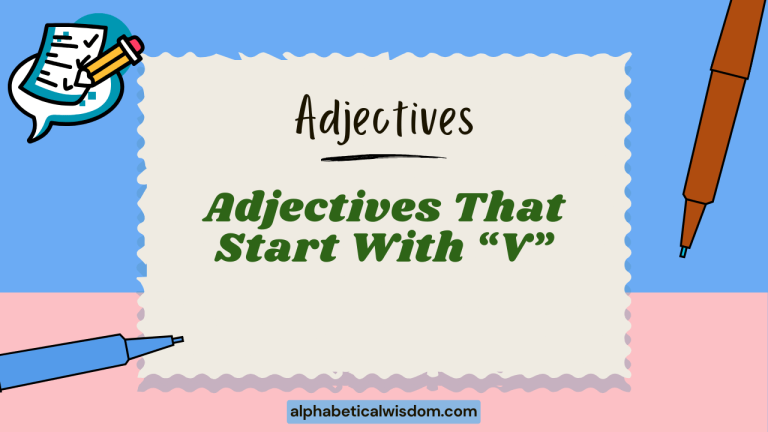Adjectives That Start With S: A Comprehensive Grammar Guide
Adjectives are the descriptive powerhouses of the English language, adding color and detail to our sentences. Mastering adjectives, particularly those starting with specific letters, expands your vocabulary and enhances your ability to communicate effectively.
This guide focuses on adjectives beginning with “S,” exploring their meanings, usage, and structural nuances. Whether you’re an English language learner or a seasoned writer aiming for precision, this article provides a thorough understanding of “S” adjectives, improving your writing and comprehension skills.
This guide is particularly useful for students learning English, writers seeking to enrich their vocabulary, and anyone interested in deepening their understanding of English grammar. By the end of this article, you will be able to confidently identify, use, and appreciate the wide range of adjectives that start with the letter “S.”
Table of Contents
- Definition of Adjectives
- Structural Breakdown of Adjectives
- Types of Adjectives Starting with “S”
- Examples of Adjectives Starting with “S”
- Usage Rules for Adjectives Starting with “S”
- Common Mistakes with Adjectives Starting with “S”
- Practice Exercises
- Advanced Topics
- Frequently Asked Questions
- Conclusion
Definition of Adjectives
An adjective is a word that modifies a noun or pronoun, providing more information about it. Adjectives describe qualities, characteristics, or attributes of the noun or pronoun they modify.
They answer questions like “What kind?”, “Which one?”, “How many?”, or “How much?” Adjectives are essential for creating vivid and detailed descriptions in both speech and writing.
Adjectives can be classified based on their function. Descriptive adjectives describe the qualities of a noun (e.g., smart student). Quantitative adjectives specify quantity (e.g., some books). Demonstrative adjectives point out specific nouns (e.g., this car). Understanding these classifications helps in using adjectives accurately.
The context in which an adjective is used can significantly affect its meaning. For example, the adjective “sharp” can describe a knife (sharp knife) or a person’s intellect (sharp mind). Therefore, paying attention to context is crucial for correct interpretation and usage.
Structural Breakdown of Adjectives
Adjectives typically precede the noun they modify, but they can also follow a linking verb (such as is, are, was, were, seem, become). This is known as attributive and predicative use, respectively. Understanding these structures is crucial for constructing grammatically correct sentences.
Many adjectives can form comparative and superlative degrees to indicate relative intensity. The comparative degree compares two things (e.g., smarter), while the superlative degree compares three or more things (e.g., smartest). The rules for forming these degrees vary depending on the length and structure of the adjective.
Adjectives can also be modified by adverbs to further refine their meaning. For instance, in the phrase “very successful,” the adverb “very” intensifies the adjective “successful.” This combination of adverbs and adjectives allows for nuanced and precise descriptions.
Types of Adjectives Starting with “S”
Descriptive Adjectives
Descriptive adjectives are the most common type, providing details about a noun’s qualities or characteristics. They cover a wide range of attributes, such as size, shape, color, condition, and origin. Examples include “sunny,” “spacious,” and “sincere.”
Descriptive adjectives enrich language by adding sensory details and emotional resonance. For instance, describing a “stormy” night evokes a sense of drama and unease, while a “serene” landscape suggests peace and tranquility. These adjectives help create vivid mental images for the reader or listener.
These adjectives are essential for painting a clear picture in the reader’s mind. They help to differentiate one noun from another, and to give additional information about the noun or pronoun they are describing.
Quantitative Adjectives
Quantitative adjectives specify the quantity or amount of a noun. While many quantitative adjectives are numbers (e.g., “six,” “seven”), some indicate an approximate amount. Adjectives starting with “S” that can function quantitatively include “some,” “several,” and “sufficient.”
These adjectives are used to provide information about how much or how many of something there is. They are particularly useful when the exact number is not known or not important.
Understanding the difference between definite and indefinite quantitative adjectives is important. Definite adjectives give a precise number, while indefinite adjectives give an approximate amount.
Demonstrative Adjectives
Demonstrative adjectives point out specific nouns, indicating which one(s) are being referred to. The primary demonstrative adjectives are “this,” “that,” “these,” and “those.” While no demonstrative adjectives start with “S,” it’s important to understand their function for a complete understanding of adjectives.
Demonstrative adjectives help to clarify which noun is being discussed, especially when there are multiple options. They create a direct link between the speaker and the noun being referenced.
The choice of demonstrative adjective depends on the proximity and number of the nouns being referred to. “This” and “that” refer to singular nouns, while “these” and “those” refer to plural nouns. “This” and “these” indicate nouns that are close, while “that” and “those” indicate nouns that are farther away.
Examples of Adjectives Starting with “S”
Adjectives starting with “S” cover a broad spectrum of meanings and connotations. They can describe positive attributes, negative qualities, or neutral characteristics.
Understanding these nuances is crucial for effective communication.
Positive Connotation
These adjectives describe favorable or desirable qualities. They are used to commend, praise, or highlight positive aspects of a noun.
Using adjectives with a positive connotation can create a favorable impression and enhance the impact of your message.
Examples include: “smart,” “successful,” “sincere,” “splendid,” “strong,” “stable,” “stylish,” “sublime,” “superb,” “sweet,” “safe,” “saintly,” “salutary,” “satisfactory,” “seamless,” “select,” “sensitive,” “sensational,” “significant,” “skillful,” “slick,” “sociable,” “solid,” “sophisticated,” “special,” “spirited,” “spotless,” “staunch,” “stellar,” “striking,” “stunning,” “substantial,” “suitable,” “sunny,” “supreme,” “surpassing,” “sustainable,” “sympathetic,” “systematic.”
The following table showcases the use of these adjectives in sentences:
| Adjective | Example Sentence |
|---|---|
| Smart | She is a smart student who always gets good grades. |
| Successful | He is a successful entrepreneur with multiple thriving businesses. |
| Sincere | Her sincere apology showed that she truly regretted her actions. |
| Splendid | The view from the mountaintop was absolutely splendid. |
| Strong | The strong bridge withstood the force of the storm. |
| Stable | The company has a stable financial foundation. |
| Stylish | She wore a stylish dress to the party. |
| Sublime | The music was sublime, filling the concert hall with emotion. |
| Superb | The chef prepared a superb meal that everyone enjoyed. |
| Sweet | The sweet aroma of the flowers filled the air. |
| Safe | The safe neighborhood is a great place to raise a family. |
| Saintly | Her saintly demeanor made everyone want to be around her. |
| Salutary | The doctor recommended salutary changes to his diet. |
| Satisfactory | The test results were satisfactory, showing improvement. |
| Seamless | The transition of power was seamless and peaceful. |
| Select | This is a select group of individuals chosen for their expertise. |
| Sensitive | She is a sensitive artist who captures emotions beautifully. |
| Sensational | The performance was sensational, leaving the audience in awe. |
| Significant | This is a significant event in the history of the company. |
| Skillful | The carpenter is skillful in his craft. |
| Slick | The company developed a slick new marketing campaign. |
| Sociable | He is a sociable person who enjoys meeting new people. |
| Solid | The building has a solid foundation and is built to last. |
| Sophisticated | The restaurant has a sophisticated menu and atmosphere. |
| Special | This is a special occasion that calls for celebration. |
| Spirited | The team played a spirited game and won. |
| Spotless | The house was spotless after she cleaned it. |
| Staunch | He is a staunch supporter of the cause. |
| Stellar | The astronaut had a stellar career. |
| Striking | She wore a striking red dress. |
| Stunning | The view was absolutely stunning. |
| Substantial | The company made a substantial profit this year. |
| Suitable | This is a suitable location for the new office. |
| Sunny | It was a sunny day at the beach. |
| Supreme | The chef used supreme ingredients. |
| Surpassing | The runner had surpassing speed. |
| Sustainable | The company has sustainable practices. |
| Sympathetic | The doctor has a sympathetic ear. |
| Systematic | The company uses a systematic approach to projects. |
Negative Connotation
These adjectives describe unfavorable or undesirable qualities. They are used to criticize, condemn, or highlight negative aspects of a noun.
Using adjectives with a negative connotation can create a critical or disapproving tone. It is important to use these carefully.
Examples include: “sad,” “savage,” “scandalous,” “scant,” “scattered,” “scornful,” “secretive,” “selfish,” “severe,” “shabby,” “shallow,” “shameless,” “shifty,” “shocking,” “shoddy,” “sick,” “silly,” “sinister,” “skeptical,” “slack,” “slimy,” “slippery,” “slovenly,” “slow,” “sluggish,” “small,” “smoggy,” “smug,” “sordid,” “sour,” “spiteful,” “squalid,” “stale,” “stingy,” “stormy,” “strained,” “strange,” “strict,” “stubborn,” “stupid,” “substandard,” “suffocating,” “sulky,” “superficial,” “suspicious,” “swollen,” “symptomatic.”
The following table showcases the use of these adjectives in sentences:
| Adjective | Example Sentence |
|---|---|
| Sad | The sad news brought tears to her eyes. |
| Savage | The savage attack left the community in shock. |
| Scandalous | The scandalous behavior of the politician was widely criticized. |
| Scant | The scant resources made it difficult to complete the project. |
| Scattered | The scattered debris showed the extent of the damage. |
| Scornful | He gave a scornful look to his opponent. |
| Secretive | Her secretive nature made it hard to trust her. |
| Selfish | His selfish actions hurt those around him. |
| Severe | The severe weather conditions caused widespread damage. |
| Shabby | The shabby old house needed repairs. |
| Shallow | The pool was too shallow to dive into. |
| Shameless | His shameless behavior was appalling. |
| Shifty | The shifty man made me feel uneasy. |
| Shocking | The shocking news left everyone speechless. |
| Shoddy | The shoddy construction was a safety hazard. |
| Sick | The sick child needed to see a doctor. |
| Silly | That was a silly mistake to make. |
| Sinister | The sinister figure lurked in the shadows. |
| Skeptical | He was skeptical of her claims. |
| Slack | The slack employee wasn’t doing his job. |
| Slimy | The slimy rock was hard to climb. |
| Slippery | The floor was slippery after the rain. |
| Slovenly | The slovenly room was a mess. |
| Slow | The slow car couldn’t keep up with traffic. |
| Sluggish | The sluggish economy needed a boost. |
| Small | The small room felt cramped. |
| Smoggy | The smoggy air was hard to breathe. |
| Smug | The smug man was not well liked. |
| Sordid | The sordid tale was a disgrace. |
| Sour | The sour milk smelled bad. |
| Spiteful | The spiteful comment was uncalled for. |
| Squalid | The squalid conditions were inhumane. |
| Stale | The stale bread was inedible. |
| Stingy | The stingy man wouldn’t share his wealth. |
| Stormy | The stormy weather kept us inside. |
| Strained | The strained relationship was difficult to maintain. |
| Strange | The strange man was acting suspiciously. |
| Strict | The strict rules were hard to follow. |
| Stubborn | The stubborn child wouldn’t listen. |
| Stupid | The stupid mistake cost them the game. |
| Substandard | The substandard work was unacceptable. |
| Substantial | The air was suffocating with pollution. |
| Sulky | The sulky teenager refused to speak. |
| Superficial | Their friendship was superficial. |
| Suspicious | The suspicious package was reported to the police. |
| Swollen | His swollen ankle was painful. |
| Symptomatic | The fever was symptomatic of the illness. |
Neutral Connotation
These adjectives describe qualities that are neither particularly positive nor negative. They provide factual or objective information about a noun without expressing a value judgment.
Using adjectives with a neutral connotation is important for maintaining objectivity and impartiality.
Examples include: “same,” “separate,” “sequential,” “several,” “similar,” “single,” “solar,” “solid,” “some,” “spatial,” “specific,” “standard,” “statistical,” “steel,” “stone,” “straight,” “strategic,” “structural,” “subjective,” “subsequent,” “subtle,” “sudden,” “sufficient,” “suitable,” “supervisory,” “surface,” “surgical,” “surrounding,” “symbolic,” “synthetic,” “systemic,” “scheduled,” “scientific,” “seasonal,” “secondary,” “sectional,” “selective,” “semantic,” “serial,” “serviceable,” “sexual,” “silent,” “silicon,” “silver,” “simultaneous,” “situational,” “social,” “sole,” “sonic,” “southern,” “spatial,” “spectral,” “spherical,” “spinal,” “spiral,” “spoken,” “square,” “stainless,” “static,” “stationary,” “statistical,” “steep,” “stereotypical,” “sticky,” “still,” “stocky,” “stoic,” “stony,” “stored,” “storeyed,” “strategic,” “stray,” “street,” “stringent,” “striped,” “strong,” “structural,” “stylistic,” “subatomic,” “submarine,” “subsidiary,” “subsonic,” “subtropical,” “suburban,” “successive,” “summarized,” “summative,” “sunken,” “sunlit,” “superannuated,” “superfine,” “superior,” “supplementary,” “supposed,” “sure,” “surmountable,” “surplus,” “surveyed,” “survival,” “sweeping,” “swift,” “switchable,” “syllabic,” “sylvan,” “symmetric,” “synchronous,” “syndicated.”
The following table showcases the use of these adjectives in sentences:
| Adjective | Example Sentence |
|---|---|
| Same | We went to the same school. |
| Separate | We need separate accounts. |
| Sequential | The steps are in sequential order. |
| Several | Several people attended the meeting. |
| Similar | The two cars are similar in design. |
| Single | He is a single man. |
| Solar | The solar panels generate electricity. |
| Solid | The table is made of solid wood. |
| Some | I need some help with this project. |
| Spatial | The study examined the spatial distribution of the population. |
| Specific | I need specific details about the incident. |
| Standard | This is the standard procedure for handling complaints. |
| Statistical | The report included statistical data about the economy. |
| Steel | The building has a steel frame. |
| Stone | The house is made of stone. |
| Straight | Draw a straight line. |
| Strategic | The company has a strategic plan for growth. |
| Structural | The engineer checked the structural integrity of the building. |
| Subjective | Grading can be subjective. |
| Subsequent | The subsequent events proved him right. |
| Subtle | There was a subtle difference between them. |
| Sudden | There was a sudden change in weather. |
| Sufficient | There is sufficient evidence to convict him. |
| Suitable | This is a suitable dress for the occasion. |
| Supervisory | He has a supervisory role. |
| Surface | The surface streets were busy with traffic. |
| Surgical | The patient needed surgical intervention. |
| Surrounding | The surrounding area is beautiful. |
| Symbolic | The dove is symbolic of peace. |
| Synthetic | The shirt is made of synthetic material. |
| Systemic | The problem is systemic. |
| Scheduled | The meeting is scheduled for next week. |
| Scientific | The scientific method requires experimentation. |
| Seasonal | We sell seasonal merchandise. |
| Secondary | The secondary source confirmed the report. |
| Sectional | We purchased a sectional couch. |
| Selective | The company is selective in its hiring practices. |
| Semantic | The researcher is studying semantic change. |
| Serial | The suspect is a serial killer. |
| Serviceable | The car is serviceable. |
| Sexual | The company has a sexual harassment policy. |
| Silent | The library is supposed to be silent. |
| Silicon | The computer chips are made of silicon. |
| Silver | The jewelry is made of silver. |
| Simultaneous | The simultaneous events had a major impact. |
| Situational | The leader needed to make a situational decision. |
| Social | We need to address the social issues. |
| Sole | He is the sole owner of the company. |
| Sonic | The plane broke the sonic barrier. |
| Southern | We visited the southern states. |
| Spatial | The study examined the spatial distribution of the population. |
| Spectral | The spectral analysis showed different wavelengths of light. |
| Spherical | The Earth is spherical in shape. |
| Spinal | He suffered a spinal injury. |
| Spiral | The staircase has a spiral design. |
| Spoken | He has a spoken agreement. |
| Square | The table is square in shape. |
| Stainless | The sink is made of stainless steel. |
| Static | The data is static. |
| Stationary | The car was stationary. |
| Statistical | The report included statistical data about the economy. |
| Steep | The hill was very steep. |
| Stereotypical | That is a stereotypical image. |
| Sticky | The tape is very sticky. |
| Still | The water was still. |
| Stocky | The man had a stocky build. |
| Stoic | The stoic man remained calm. |
| Stony | The ground was stony. |
| Stored | The data is stored in the cloud. |
| Storeyed | The building is many storeyed. |
| Strategic | The company has a strategic plan for growth. |
| Stray | The stray dog was looking for food. |
| Street | The street lights were on. |
| Stringent | The company has stringent safety standards. |
| Striped | The cat is striped. |
| Structural | The engineer checked the structural integrity of the building. |
| Stylistic | The author has a stylistic flair. |
| Subatomic | The research focused on subatomic particles. |
| Submarine | The submarine explored the ocean depths. |
| Subsidiary | It is a subsidiary company. |
| Subsonic | The plane flew at subsonic speed. |
| Subtropical | The climate is subtropical. |
| Suburban | They live in a suburban neighborhood. |
| Successive | The team won successive games. |
| Summarized | The paper was summarized in the abstract. |
| Summative | The final exam was summative. |
| Sunken | The sunken ship was undiscovered for years. |
| Sunlit | The room was sunlit. |
| Superannuated | The computer was superannuated. |
| Superfine | The sugar was superfine. |
| Superior | This is the superior product. |
| Supplementary | The textbook had supplementary material. |
| Supposed | He is the supposed leader. |
| Sure | He is a sure candidate to win. |
| Surmountable | The challenge is surmountable. |
| Surplus | The company had a surplus of products. |
| Surveyed | The land was surveyed. |
| Survival | The survival rate is high. |
| Sweeping | The changes were sweeping. |
| Swift | The car was swift. |
| Switchable | The lights are switchable. |
| Syllabic | The text was syllabic. |
| Sylvan | The setting was sylvan. |
| Symmetric | The shape is symmetric. |
| Synchronous | They performed a synchronous dance. |
| Syndicated | The columnist had a syndicated article. |
Usage Rules for Adjectives Starting with “S”
Adjectives, including those starting with “S,” follow specific rules regarding their placement and function within a sentence. Understanding these rules is crucial for using adjectives correctly and effectively.
Attributive Use
In attributive use, the adjective precedes the noun it modifies. This is the most common placement for adjectives. For example: “a successful business,” ”
a sincere apology,” “the same school.”
When using multiple adjectives attributively, they generally follow a specific order based on their type (e.g., opinion, size, age, shape, color, origin, material, purpose). This order ensures clarity and coherence in your descriptions. For example: “a beautiful large old round brown wooden coffee table.”
The placement of adjectives can affect the emphasis of the sentence. Placing the most important adjective closest to the noun can highlight that attribute. For example: “a truly remarkable achievement” emphasizes the remarkableness of the achievement.
Predicative Use
In predicative use, the adjective follows a linking verb (such as “is,” “are,” “was,” “were,” “seem,” “become”) and modifies the subject of the sentence. For example: “The business is successful,” “The apology seemed sincere,” “The schools are the same.”
Unlike attributive adjectives, predicative adjectives do not directly precede the noun they modify. Instead, they are connected to the noun through a linking verb, forming a subject complement.
Some adjectives can only be used predicatively and cannot be used attributively. While this is not common with adjectives starting with “S,” it’s a good idea to be aware of this possibility when using adjectives in general.
Comparative and Superlative Forms
Many adjectives can form comparative and superlative degrees to indicate relative intensity. The comparative degree compares two things, while the superlative degree compares three or more things.
The rules for forming these degrees vary depending on the length and structure of the adjective.
For most one-syllable adjectives starting with “S,” the comparative is formed by adding “-er” and the superlative by adding “-est” (e.g., “smart,” “smarter,” “smartest”). For longer adjectives, use “more” and “most” (e.g., “successful,” “more successful,” “most successful”).
Irregular adjectives have unique comparative and superlative forms that do not follow the standard rules. However, there are no common irregular adjectives that start with “S.”
Common Mistakes with Adjectives Starting with “S”
Using adjectives correctly can be challenging, and there are several common mistakes to watch out for, especially with adjectives starting with “S.”
- Misusing Comparative and Superlative Forms: Incorrectly forming the comparative or superlative degree of an adjective.
Incorrect: She is the sincerest most sincere person I know.
Correct: She is the most sincere person I know.
- Incorrect Adjective Order: Placing adjectives in the wrong order when using multiple adjectives attributively.
Incorrect: a wooden brown large large brown wooden table.
Correct: a large brown wooden table.
- Confusion Between Similar Adjectives: Mixing up adjectives with similar meanings but different connotations or usages.
Incorrect: The strategic strategic plan was well-executed.
Correct: The strategic plan was well-executed.
- Using Adjectives as Adverbs: Using an adjective in place of an adverb, or vice versa.
Incorrect: He performed successful. successfully
Correct: He performed successfully.
Practice Exercises
Test your understanding of adjectives starting with “S” with these practice exercises.
Exercise 1: Identifying Adjectives
Identify the adjectives in the following sentences:
- The smart student aced the exam.
- The sincere apology was accepted.
- Several people attended the meeting.
- The old house was sturdy.
- The movie had a sad ending.
Answers:
- smart
- sincere
- Several
- old, sturdy
- sad
Exercise 2: Using Adjectives in Sentences
Fill in the blanks with an appropriate adjective starting with “S”:
- She is a ___________ dancer.
- The company made ___________ progress this year.
- The weather was ___________ all day.
- The man was ___________ of the situation.
Possible Answers:
- skillful
- substantial
- stormy or sunny
- suspicious
Exercise 3: Correcting Mistakes
Correct the mistakes in the following sentences:
- She is the sincerest person I know.
- The wooden brown large table was expensive.
- He performed successful on the stage.
Corrected Sentences:
- She is the most sincere person I know.
- The large brown wooden table was expensive.
- He performed successfully on the stage.
Advanced Topics
For those looking to deepen their understanding of adjectives, here are some advanced topics to explore.
Adjective Order
When using multiple adjectives to describe a noun, they generally follow a specific order. While not a strict rule, adhering to this order can make your writing clearer and more natural.
The general order is:
- Opinion
- Size
- Age
- Shape
- Color
- Origin
- Material
- Purpose
For example:
a beautiful large old round brown wooden coffee table
Figurative Language with “S” Adjectives
Adjectives can be used in figurative language to create vivid and imaginative descriptions. Similes and metaphors are common techniques that employ adjectives to draw comparisons and create deeper meaning.
- Simile: A comparison using “like” or “as.”
The sea was as still as glass.
- Metaphor: A direct comparison stating that one thing is another.
His heart was a stone.
Frequently Asked Questions
What is the difference between an adjective and an adverb?
An adjective modifies a noun or pronoun, while an adverb modifies a verb, adjective, or another adverb. Adjectives describe nouns, while adverbs describe actions or qualities.
Can an adjective modify another adjective?
No, an adjective cannot modify another adjective. Only adverbs can modify adjectives.
For example, “very successful” is correct because “very” is an adverb modifying the adjective “successful.”
Are there any adjectives that start with “S” that can only be used predicatively?
While most adjectives starting with “S” can be used both attributively and predicatively, it’s always good to check a dictionary for specific usage notes.
Conclusion
Adjectives starting with “S” offer a rich variety of descriptive words that can enhance your writing and communication skills. By understanding their meanings, connotations, and usage rules, you can use these adjectives effectively to create vivid descriptions, express nuanced opinions, and maintain clarity in your language.
Whether you are describing a “smart” student, a “stormy” night, or a “statistical” report, mastering adjectives starting with “S” is a valuable asset in your linguistic toolkit. Continue practicing and exploring new adjectives to further expand your vocabulary and refine your writing style.
